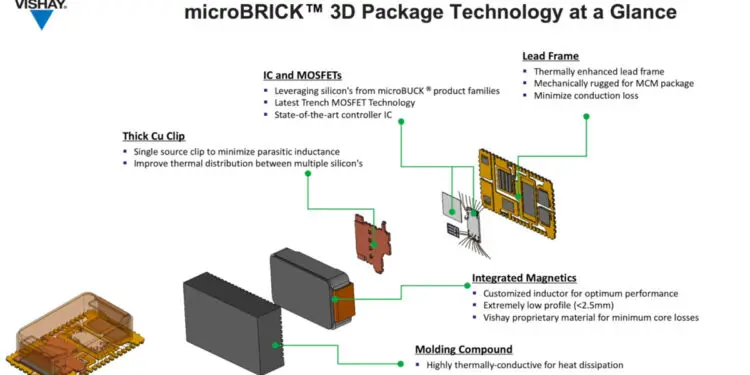Vishay Intertechnology, Inc. announced that the Vishay Siliconix microBRICKTM family point of load (POL) DC/DC converter modules has been recognized by Elecfans with a “Most Innovative Products” of 2020 China Artificial Intelligence (AI) Innovation Excellence Award in the “Intelligent Sensor / Storage / Power Management” category.
Held for the first time this year, the China AI Excellence Innovation Awards recognize products and technologies introduced over the past year that have delivered a far-reaching impact on the AI industry. Finalists are determined by online voting, with Elecfans editors and industry experts voting to select the winners. In the “Intelligent Sensor / Storage / Power Management” category, Vishay’s microBRICKTM modules were recognized for giving designers compact, easy-to-use, price-competitive solutions, with efficiency up to 95 % for POL conversion.
A microBRICKTM module includes a power IC, two MOSFETs, and inductor within a low profile QFN package measuring 10.6 mm x 6.5 mm x 3 mm high — 60 % smaller volume than the next closest competing product. The devices offer several advantages, both thermal and electrical, to overcome the challenges of smaller packages in DC/DC converters, delivering improved heat dissipation, lower junction temperature, higher reliability, and a wider safe operating area to support higher ambient temperatures or to compensate for smaller board space.
The microBRICKTM family includes 6 A, 20 A, and 25 A modules for computing, consumer electronics, telecom, and industrial applications. For example, the SiC931 20 A module is not only the smallest 20 A device on the market, but its 4.5 V to 20 V input voltage range is the widest, its 1 μA supply current at shutdown is the lowest, and its 90 % maximum duty cycle is 3x higher than the closest competing device. The module’s compact size dramatically increases power density, while its high level of integration reduces design complexity and improves overall system reliability.
Award winners were announced at an awards ceremony on July 10 during the third annual 2020 Artificial Intelligence Conference, which was held online this year due to the COVID-19 pandemic. A complete list of winners can be found at http://www.elecfans.com/d/1244356.html.
































